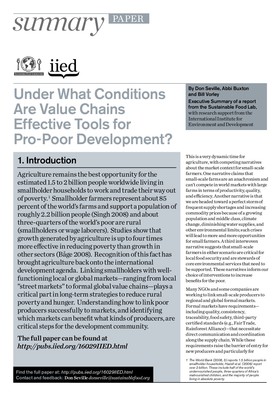Under what conditions are value chains effective for pro-poor development - summary paper
Agriculture remains the best opportunity for the estimated 1.5 to 2 billion people worldwide living in smallholder households to work and trade their way out of poverty. 1 Smallholder farmers represent about 85 per cent of the world’s farms and support a population of roughly 2.2 billion people (Singh 2008) and about three-quarters of the world’s poor are rural(smallholders or wage laborers). Studies show that growth generated by agriculture is up to four times more effective in reducing poverty than growth in~other sectors (Båge 2008). Recognition of this fact has brought agriculture back onto the international development agenda. Linking smallholders with wellfunctioning local or global markets—ranging from local “street markets” to formal global value chains—plays a critical part in long-term strategies to reduce rural poverty and hunger. Understanding how to link poor producers successfully to markets, and identifying which markets can benefit what kinds of producers, are critical steps for the development community.
Cite this publication
Available at https://www.iied.org/g03136






